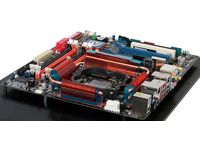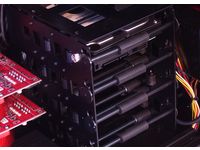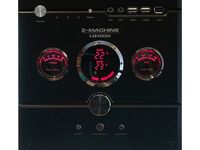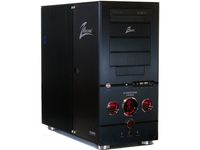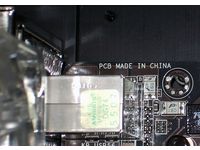Three High-End Liquid-Cooling Cases Compared
LQ1000 Installation and Operation
Installing the LQ1000’s ZM-WB5 CPU water block begins with a bracket of the same design as other Zalman CPU heat sinks. Notice that we removed the motherboard plate for photography purposes, but this isn’t required (nor helpful) for typical installations.
Hard drives slide easily into place across rollers, where a drop-down bar retains them. A thumbscrew can provide additional security if needed. We were disappointed to find the bars made of flexible plastic, rather than a stiffer material.
We reinstalled the motherboard plate, followed by the graphics cards and RAM, before trimming and attaching coolant lines and filling and purging the air from the cooling system. Zalman recommends removing the CPU water block prior to initial purging, as doing so allows air to rise out of crevices in the water block.
Notice that very little room remains under the bottom graphics card of our CrossFire configuration. The water pump blocks longer cards from being inserted into or over the bottom slot, which could prevent several SLI systems from being used. Recent SLI motherboards typically rely on slot numbers six and seven for the graphics cards and their extra-thick coolers. For cards such as the GTX 280, the only workaround is to use liquid cooling to reduce thickness, thereby freeing up the space of the seventh slot.
Zalman could have easily opened up the lowest slot of its case by using an integrated pump/water block such as Swiftech’s Apogee Drive 350, but doing so would have required the firm to step outside of its own product line—which would be an unlikely scenario. Additionally, getting the water line “out of the way” could have been achieved by angling the elbow at the bottom of the radiator approximately 60 degrees upward.
Another potential issue for builders of high-end gaming systems is the LQ1000’s limited card length of 10 11/16”. Super-long cards such as the HD 4870 X2 and GTX-280 are a tight fit, but the real problem occurs when slightly shorter cards with power connectors on the leading edge are installed. There’s very little room to insert a power cable between the hard drive cage and a card, forcing us to first connect the power connectors to our cards, then fold the cable over far too tightly before slipping the cards into place.
The Z-Machine LQ1000 supports two operational modes: automatic and manual pump/fan speed. Manual speed is controlled by an analog dial on the front of the case, marked “Volume.” At its lowest speed, the LQ1000 is quieter than most pre-built systems, while at its highest speed, noise levels are slightly higher than the “lowest” settings of the competing Koolance PC5-1326SL. Based on the ratings of the LQ1000’s cooling fans, we estimate noise levels to be around 38 decibels at the highest settings.
Get Tom's Hardware's best news and in-depth reviews, straight to your inbox.
Because of the thick panels and ventilated left side, the LQ1000 showed odd characteristics for containing the noise of internal components such as the fans of our graphics cards. Noise isolation when observed at 45 degrees to the right corner of the case was excellent, while the noise level from the same angle to the left side was much more unpleasant. We suggest placing the system to the left of your monitor for the best experience.
Zalman, of course, would like you to add one of its graphics water blocks to your system. But the company hasn’t released anything yet for recent high-end cards. Feel free to consider other brands of graphics water blocks if Zalman doesn’t have what you need—they’ll still work.
Finally, one issue that drove us crazy was the motherboard mounting holes, which were approximately 1/8” too high and too far forward (away from the port and slot panel). We slid the motherboard plate as far down and rearward against the case as we could, then loosened the motherboard screws and slid it as far down and rearward against the mounting plate as we could. However, we were still confronted by ports that didn’t align properly with the holes of our cover plate and cards that didn’t quite reach the mounting screws. Pushing and twisting allowed us to finish our installation, but the system wasn’t quite right. This is something that no high-end buyer should be forced to accept.
We ordered a retail LQ1000 to find out if the problem is unique to this review sample, and our findings on the retail part were just as unfortunate:
With our test motherboard in perfect alignment with the port panel and slot plate, the holes of the support plate aren’t even close to being centered on the motherboard. We further checked to be certain the problem was not a fault in our motherboard, and confirmed that the misalignment is unique to Zalman.
This type of misalignment is typically caused by rounding errors in the conversion from inches to millimeters. We have no idea why anything as modern as the ATX form factor is based on inch measurements, but the problem indicates that either Zalman made a mistake, or "everyone else" did.
Current page: LQ1000 Installation and Operation
Prev Page Zalman Z-Machine LQ1000 Design and Features Next Page Tom’s Hardware’s Liquid-Cooled Case-
or buy a cheap case... mod it with a 50 $ dremel... and then add your own watercooling setup and get much better cooling performance...Reply
thats what i'm going to do... not buy some case w/ water cooling.... unless its like a modded lian-li case... but those are like 800 bucks... so no thanks -
nerrawg Whoa the 4870 is still a pretty hot one even with that massive Koolance radiator. I wonder if that can be improved using a custom build with 2 separate loops and radiators - would be a bit more hassle though. Also be interesting to see how it compares to a 4870 X2 - my first assumption would be the X2 is hotter but that might not be the case as there could be a larger flow and surface area to allow for more heat dissipation. If your talking W/C for silent running, then custom built systems with big passive radiators (Toyota anyone?) and a good pump or 2 has to be the only true solution. Otherwise you're just running fans like an air cooling rig and the name of the game is still who has the quietest one..Reply -
yadge nerrawgWhoa the 4870 is still a pretty hot one even with that massive Koolance radiator. I wonder if that can be improved using a custom build with 2 separate loops and radiators - would be a bit more hassle though. Also be interesting to see how it compares to a 4870 X2 - my first assumption would be the X2 is hotter but that might not be the case as there could be a larger flow and surface area to allow for more heat dissipation. If your talking W/C for silent running, then custom built systems with big passive radiators (Toyota anyone?) and a good pump or 2 has to be the only true solution. Otherwise you're just running fans like an air cooling rig and the name of the game is still who has the quietest one..Reply
I'm pretty sure the videocards weren't water cooled. -
nerrawg Hehe whoops you're right - I guess I should have looked at the pics - no wonder it was so hot. Don't understand why they didn't use some splitters and cool 4870beast #1. Can't see how you can complain about noise and temp when you're not even using your full 750-1000W water cooling capasity. Also good eye editor on changing frames per sec to temperature celsius on graph X axis.Reply -
gaiden nice info, though i'm not sure, as hardware gets smaller - lesser heat, would i need a water-cooled setup. personally i think fan setup with a top of the line HS would do plenty. the TJ-09 and Lian Li's are very well built - i have a 7 fan setup + IFX-14 in a lian li 2100 plus II cant hear anything at all. (though it really helps to get good fans :) for GPU's there are several 'spot-cooler' options. overall 7-8 'good' fans + 1 'awesome' cooler would cost only less than 1/2 of the $500 TH spent on water-cooled solution, and the air-cooled should improve air movement inside the case as well.Reply -
stoner133 I find it strange that the video card temps are so high, I run a Koolance system and using their waterblocks on both of my 4870's in crossfire my temps never get above 42c after hours of playing Crysis and my coolent reaches the GPU's after it goes thru the CPU waterblock. The two degree temp difference does happen, AOD does show the first card at 40c while the second is 42c.Reply -
stoner133 thogromor buy a cheap case... mod it with a 50 $ dremelhttp://en.wikipedia.org/wiki/Dremel ... and then add your own watercooling setup and get much better cooling performance... thats what i'm going to do... not buy some case w/ water cooling.... unless its like a modded lian-lihttp://en.wikipedia.org/wiki/Lian_Li case... but those are like 800 bucks... so no thanksThe Koolance cases are modded Lian Li cases and there no where near $800, they start at just under $400 and go to just over $600Reply -
Shadow703793 They could have silver plated the Koolance CPU-340 block instead of gold plating it (silver > than gold in heat transfer).Reply
These kits are worth an entire PC so imo, I would mod it my self. It's not that hard to do, providing you have the time to do it. -
Crashman Reply9463632 said:The Koolance cases are modded Lian Li cases and there no where near $800, they start at just under $400 and go to just over $600
The case with no pump, water block, or reservoir is $400, but what do you do without the parts? A basic liquid cooling kit from Koolance, complete with only the needed parts, starts at around $600.
Also notice:
Test Configuration
Liquid cooling often offers excellent cooling capacity, but that wouldn’t matter much if hot case air destabilized another part of the system. In order to test both, we used an overclockedhttp://en.wikipedia.org/wiki/Overclocking Intel Core 2 Quad processor to heat the liquid and a pair of HD 4870http://en.wikipedia.org/wiki/Radeon_R700 X2 graphics cards to heat the air.
Graphics was left air-cooled to help determine effectiveness of case airflow. It would have been even better to use two 4850's for that, since they don't vent outside the case.
